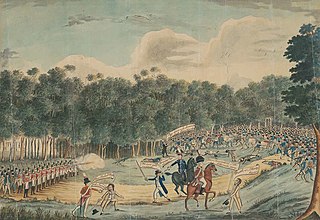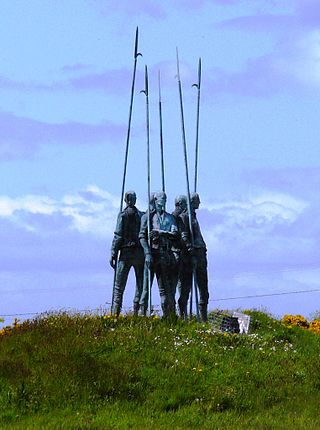
Philip Gidley King was a British politician who was the third Governor of New South Wales.

The Irish Rebellion of 1798 was a popular insurrection against the British Crown in what was then the separate, but subordinate, Kingdom of Ireland. The main organising force was the Society of United Irishmen. First formed in Belfast by Presbyterians opposed to the landed Anglican establishment, the Society, despairing of reform, sought to secure a republic through a revolutionary union with the country's Catholic majority. The grievances of a rack-rented tenantry drove recruitment.

Castlebridge is a small town on the R741 regional road in County Wexford, Ireland, around 5 km north of Wexford Town. It is located near the River Slaney and just north of Wexford Harbour. Castlebridge is a rapidly expanding suburb of Wexford Town; its population has almost tripled in 20 years, increasing from 783 in 1996 to a population of 1,840 in 2016.

The Castle Hill convict rebellion was an 1804 convict rebellion in the Castle Hill area of Sydney, against the colonial authorities of the British colony of New South Wales. Led by veterans of the United Irish Rebellion of 1798, the poorly armed insurgents confronted the colonial forces of Australia on 5 March 1804 at Rouse Hill. Their rout in the resulting skirmish was hailed by loyalists as Australia's Vinegar Hill after the 1798 Irish Battle of Vinegar Hill, where rebels in Ireland were decisively defeated. The incident was the first major convict uprising in Australian history to be suppressed under martial law.
The history of Australia from 1788 to 1850 covers the early British colonial period of Australia's history. This started with the arrival in 1788 of the First Fleet of British ships at Port Jackson on the lands of the Eora, and the establishment of the penal colony of New South Wales as part of the British Empire. It further covers the European scientific exploration of the continent and the establishment of the other Australian colonies that make up the modern states of Australia.

Irish Australians are an ethnic group of Australian citizens of Irish descent, which include immigrants from and descendants whose ancestry originates from the island of Ireland.
James Meehan was an Irish Australian explorer and surveyor.

Joseph Holt was a United Irish general and leader of a large guerrilla force which fought against British troops in County Wicklow from June–October 1798. He was exiled in 1799 to the colony of New South Wales where he worked as a farm manager for NSW Corp Paymaster Captain William Cox and later returned to Ireland in 1814.

Michael Dwyer was an insurgent captain in the Irish Rebellion of 1798, leading the United Irish forces in battles in Wexford and Wicklow., Following the defeat and dispersal of the rebel hosts, in July 1798 Dwyer withdrew into the Wicklow Mountains, and to his native Glen of Imaal, where he sustained a guerrilla campaign against British Crown forces.

John Murphy was an Irish Roman Catholic priest of the Roman Catholic Diocese of Ferns, who is mainly remembered for his central role in the Irish Rebellion of 1798 in County Wexford, which is sometimes known as the Wexford Rebellion. He led the rebels to one of their initial victories over a government militia at Oulart Hill, and in the following weeks became one of the rebellion's main leaders.
Events from the year 1798 in Ireland.
Beauchamp Bagenal Harvey was a barrister and a commander of the United Irishmen in the Battle of New Ross during the 1798 Rebellion.

The Wexford Rebellion refers to the events of the Irish Rebellion of 1798 in County Wexford. From 27 May until 21 June 1798, Society of United Irishmen rebels revolted against British rule in the county, engaging in multiple confrontations with Crown forces. The most successful and destructive rising in all the counties of Ireland, United Irishmen rebels experienced a number of early successes in the county despite being seen as a relatively loyal county by the Dublin Castle administration due to a series of military victories. However, the tide soon turned against the United Irishmen in Wexford as Crown forces poured into the region, engaging in a brutal counterinsurgency which indiscriminately targeted suspected rebels and eventually suppressed all rebel activities in the county.
Edward Hay (1761–1826) was the author of a book on the Irish Rebellion of 1798, and a witness to many of the events of that time.

Crossabeg or Crosabeg is a small village in County Wexford, Ireland, just north of Wexford town. It contains The Forge Storytelling House, Foley's Pub, St Patrick, St Brigid and St Killian's Catholic church with adjoining cemetery and a primary school.

The Irish rebellion of 1803 was an attempt by Irish republicans to seize the seat of the British government in Ireland, Dublin Castle, and trigger a nationwide insurrection. Renewing the struggle of 1798, they were organised under a reconstituted United Irish directorate. Hopes of French aid, of a diversionary rising by radical militants in England, and of Presbyterians in the north-east rallying once more to the cause of a republic were disappointed. The rising in Dublin misfired, and after a series of street skirmishes, the rebels dispersed. Their principal leader, Robert Emmet, was executed; others went into exile.
The Apostolic Prefecture of New Holland was a short-lived (1816–1819) Roman Catholic missionary jurisdiction in colonial Australia.
James Dempsey, transported from Ireland following the 1798 rebellion, was the founder of the first Roman Catholic community in Australia and was a major contributor to the building of the first Catholic cathedral in Australia.

The St Patrick's Catholic Church is the oldest surviving Catholic church in Sydney, New South Wales, Australia. Opened in 1844, it is located at the junction of Grosvenor and Gloucester Streets in the inner city suburb of The Rocks in the City of Sydney. It is also known as St Patrick's, Church Hill or St Pat's Church Hill. The property is owned by the Trustees of the Roman Catholic Archdiocese of Sydney. The Marist Fathers, a religious order, have administered the parish since 1868.












